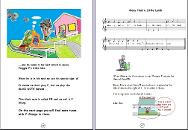
Welcome to Doggie-D's Piano Course!
The course comprises three books and we now have a number of children working at all three levels, very successfully.
To keep costs down, we are selling the links to
Doggie-D's books so you can print them off yourself.
Why yet another beginners' piano book?
Most existing courses work by placing the hands over a set of "home keys". Much like learning to touch-type.
As with typing, the child learns to associate each finger with a note.
(eg. Thumb on middle C, 2nd finger on D, etc.)
But the problem is, that, not only is the child expected to memorise the finger positions of two hands, but the left hand numbering is a back-to-front replica of the right, whilst the alphabetic order of notes in the left hand is NOT reversed!
This can cause a lot of confusion, and young children often completely give up on trying to understand, believing it is far beyond them, and rely, instead, on pure guesswork.
("Teacher will put me right if I sit here guessing long enough!")
Furthermore, as if that weren't enough, they find, after a few weeks, that one or both hands move to another set of "home keys"!
From then on, the child cannot rely on the helpful fingering marks above the notes.
("Right hand 3rd finger used to be on E,
but now it is somewhere else")!
Doggie-D's Piano Course sets about teaching the notes in a completely different way. There is nothing new about using animals to represent the notes:-
(Dog = D, Elephant = E etc)
But Doggie-D has some fundamental differences in approach:
Doggie-D does not even associate the right hand with the treble clef or the left with the bass!
Doggie-D does not require the child to memorise the 1st 7 letters of the alphabet in reverse.
Doggie-D uses a two-treble clef system in the first book.
Doggie-D does not teach middle C as pivotal between two clefs.
Doggie-D does not involve the repeated "trauma" of "home-key-set" changes.

The child is encouraged to experiment with using either hand. - And the bass clef is not introduced until book 2, (when it is seen as just a lower flight of stairs, following the same pattern as the treble).
The child associates the notes with animal and human characters who inhabit the various steps in a terraced garden. The black notes are part of the "story", so it is easy for the child to recognise the position of any note on the steps.
The child comes to understand that the right hand usually plays the top stave, and the left, the bottom, but that this need not necessarily be the case. In book 1 there is very little hands-together work, so most of it could be played by one hand or the other. The child is encouraged to play everything with right hand, left hand, and also both hands in the more conventional manner.
Middle C is simply a cat who roams between the two flights of steps. So he can be played with either hand, according to convenience, no matter which clef he appears in.
There are no home-keys. The hands simply play on the steps, the way a child would!

christhepiano.cb@gmail.com